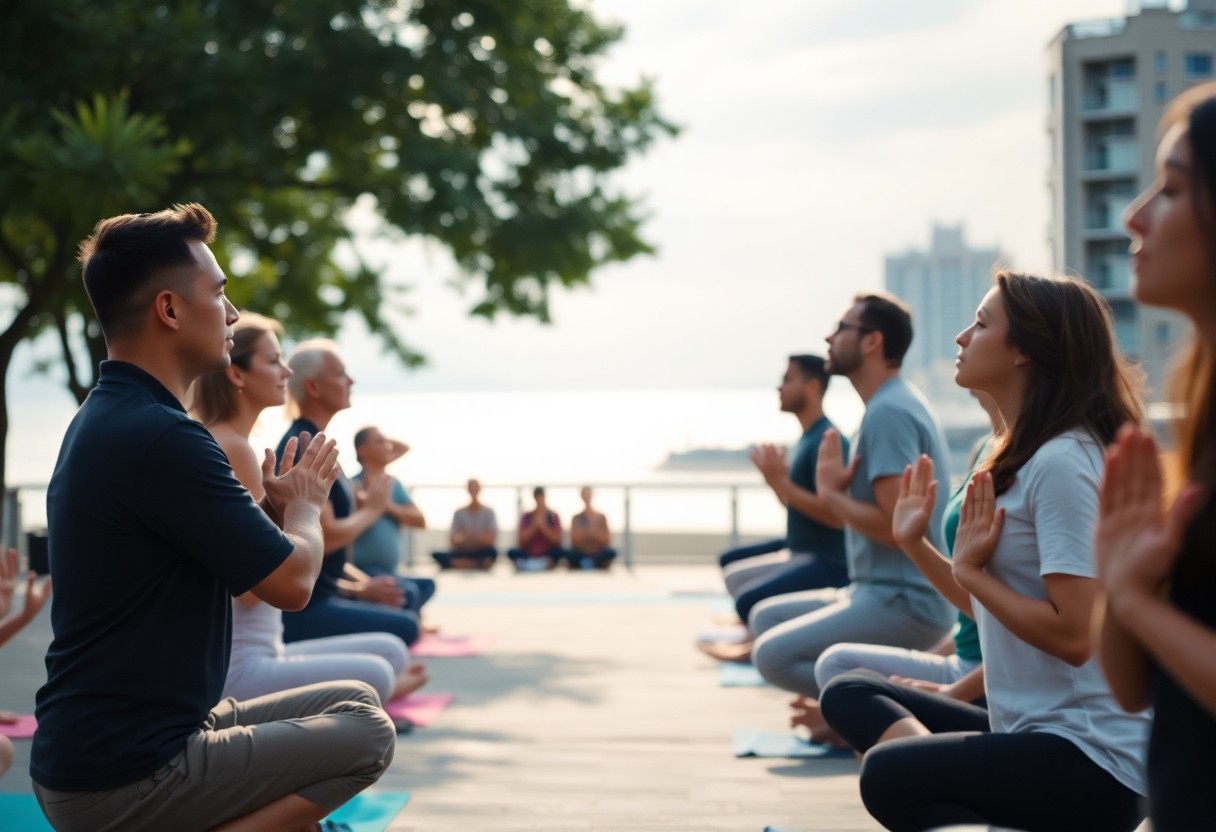Breathing plays a vital role in managing stress and enhancing your overall well-being. With the WorkWell – Quick Calm program, you can engage in quick and effective breathing exercises wherever you are. These simple techniques not only promote relaxation but also help you regain focus amidst the chaos of daily life. By incorporating these strategies into your routine, you can transform brief moments into opportunities for renewed energy and calm. Discover how you can take control of your stress and improve your mental clarity with just a few deep breaths.
Key Takeaways:
- WorkWell – Quick Calm offers a variety of breathing exercises designed to help users quickly reduce stress and anxiety, making it easy to integrate mindfulness into daily routines.
- The app features guided sessions that can be utilized anywhere and at any time, promoting relaxation whether at work, home, or on the go.
- User-friendly interface allows for quick access to exercises, helping individuals practice mindfulness effortlessly during busy moments.
The Importance of Breathing Exercises
Your ability to harness the power of breathing exercises can significantly impact your overall well-being. These exercises serve as an effective tool for enhancing your mental clarity, emotional stability, and physical health. By integrating simple breathing techniques into your daily routine, you can create a sanctuary amidst the chaos of everyday life, allowing yourself to center and rejuvenate whenever needed.
Benefits of Deep Breathing
Behind deep breathing lies a wealth of benefits that extend beyond mere relaxation. Engaging in deep breathing can improve your lung capacity, increase oxygen flow to your brain, and enhance your focus. Additionally, it fosters a deep sense of calm, allowing you to approach tasks and challenges with a clear mind and greater resilience.
Breathing and Stress Relief
Along with its myriad benefits, deep breathing plays a vital role in alleviating stress. By consciously engaging in breathwork, you can activate your body’s natural relaxation response, diminishing the effects of stress and anxiety that accumulate throughout the day.
A consistent practice of deep breathing can lead to substantial improvements in your stress levels. When you focus on your breath, you signal your body to enter a state of calm, effectively reducing feelings of tension and anxiety. This technique not only promotes mental clarity but also lowers blood pressure and decreases heart rates. By incorporating these exercises into your routine, you can gain control over stressful situations and cultivate a more balanced emotional state, ultimately enhancing your quality of life.

Quick Calm Techniques
One effective way to manage stress and anxiety is through quick calm techniques. Implementing these breathing exercises throughout your day enables you to regain focus and soothe your mind, whether you’re at work, home, or anywhere in between. With just a few minutes dedicated to these methods, you can experience a sense of tranquility and improved mental clarity.
4-7-8 Breathing
About the 4-7-8 breathing technique, it is designed to promote relaxation and improve your sleep quality. By inhaling for a count of four, holding the breath for seven, and exhaling for eight, you can effectively engage your body’s natural relaxation response. This rhythmic pattern calms the nervous system and reduces anxiety, making it an excellent tool for stressful situations.
Box Breathing
On the other hand, box breathing is a simple method that can ground you in the present moment. This technique involves inhaling for a count of four, holding for four, exhaling for four, and resting for another four. It’s perfect during times of stress, enabling you to maintain stability and clarity.
Considering incorporating box breathing into your routine, you will find it particularly useful in high-pressure situations. As you engage in this method, each controlled breath enhances your body’s oxygen flow, which can lead to improved focus and emotional regulation. Additionally, it helps lower heart rates and reduce feelings of panic, providing you with a calming effect that enables you to tackle challenges more effectively. This technique is not only beneficial for your mental state but also promotes overall well-being.

Breathing Exercises for Different Environments
After settling into your day, it’s necessary to tailor your breathing exercises to different environments. Whether you’re at work, at home, or out and about, these techniques can help you regain focus and calmness. Adapting your practices to your surroundings not only enhances their effectiveness but also ensures you can find tranquility whenever you need it.
At Work
Before submerging into tasks, take a moment to breathe. Incorporating short, mindful breathing exercises during your workday can help alleviate stress and improve your productivity. Try a simple technique: inhale for a count of four, hold for four, then exhale for six, repeating this several times to recenter yourself.
At Home
At home, you have the luxury of comfort and flexibility. Use your environment to your advantage by creating a dedicated space for mindfulness. You can include soft lighting and calming scents to enhance your breathing exercises. By practicing regularly in this cozy setting, you set the stage for a peaceful mind.
Understanding the importance of relaxation at home empowers you to take charge of your mental well-being. This personal sanctuary allows you to engage in more extended exercises, such as diaphragmatic breathing or the 4-7-8 technique. By committing to these routines, you foster a positive mindset that can enhance your overall quality of life. Prioritizing these moments amid the chaos of daily life can help cultivate a sense of peace and balance.
Incorporating Breathing Exercises into Your Routine
Keep breathing exercises at the forefront of your daily activities by integrating them into your routine. You can start with just a few minutes each day, gradually increasing the duration as you become more comfortable. Consider exploring 8 Mindfulness Breathing Exercises You Can Do Anywhere, … to find techniques that suit your lifestyle, making it easier to embrace a calming practice wherever you are.
Setting Reminders
About setting reminders for your breathing exercises, using alerts on your phone or sticky notes can effectively prompt you to take a moment for yourself. Choose times that align with your daily activities, such as before meetings or during lunch breaks, to create a habit of relaxation.
Creating a Calm Space
On creating a calm space, it’s imperative to designate a specific area for your breathing exercises, whether it’s at home or in the workplace. This space should be quiet, free from distractions, and infused with tranquility to facilitate focus.
Breathing in a calm environment significantly enhances your exercise experience. Ensure your space feels inviting by adding elements like soft lighting, comfortable seating, or calming scents. Eliminate noise and clutter to foster an atmosphere of peace. By investing time in your surroundings, you empower yourself to cultivate a positive mindset, allowing you to recharge and rejuvenate effectively while practicing your breathing exercises.
Mindfulness and Breath Connection
Unlike many aspects of daily life that can lead to stress, the practice of combining mindfulness with your breath serves as an anchor. When you center your awareness on your breathing, you invite a sense of calm and presence that helps you navigate challenging moments. This connection allows you to observe thoughts without judgment, creating space for relaxation and clarity.
The Role of Mindfulness
Against a backdrop of constant distractions, mindfulness provides a sanctuary. By actively practicing mindfulness, you cultivate an awareness of the present moment, enabling you to engage fully with your surroundings, thoughts, and feelings. This heightened state of awareness can significantly enhance your emotional well-being.
Enhancing Focus with Breath
About engaging your breath can transform your ability to concentrate. By focusing on your breath, you create a natural pause that improves your mental clarity and enhances cognitive performance. This practice shifts your attention from distractions, allowing you to reset and refocus on the task at hand, leading to increased productivity.
With simple breathing exercises, you can take control of your focus throughout the day. When you inhale deeply, you’re not just filling your lungs; you’re inviting a rush of oxygen that energizes both your body and mind. As you exhale, you release tension and unnecessary thoughts, allowing your brain to function more efficiently. This process aids in reducing mental fatigue and helps you maintain concentration on important tasks, making it an effective tool for achieving peak performance in your daily endeavors.
Tips for Effective Practice
Despite the many benefits of breathing exercises, you may find it challenging to incorporate them into your routine. Here are a few tips to enhance your efficacy:
- Choose a time that works best for you.
- Create a quiet, comfortable space.
- Use guided sessions when needed.
- Focus on your breath, minimizing distractions.
- Keep a consistent practice schedule.
Recognizing these elements can significantly improve your experience of practicing breathing exercises anywhere.
Consistency is Key
By establishing a consistent routine, you are more likely to see positive changes in your stress levels and overall well-being. Make it a habit, whether through daily practice or short sessions throughout the day, to maximize the benefits.
Personalizing Your Experience
After understanding the basics of breathing exercises, you should tailor your practice to fit your individual needs. This personalization can enhance your connection to the exercises and improve your overall effectiveness.
At the heart of your personalized experience is knowing what works best for you. Whether it’s selecting specific breathing techniques that resonate with your needs or incorporating calming visuals and scents, these factors can shape an enriching atmosphere. Ensure you take time to explore different methods, such as deep diaphragm breathing or box breathing, and adapt them to your style. The more you engage with tailored practices, the more natural and beneficial they will feel, ultimately fostering lasting positive changes in your life.
Conclusion
Conclusively, with WorkWell – Quick Calm, you can easily integrate effective breathing exercises into your daily routine, regardless of where you are. This tool empowers you to enhance your mindfulness and reduce stress effectively. By utilizing these short practices, you not only improve your well-being but also cultivate a sense of calm amidst the chaos of daily life. Embrace the convenience and benefits of Quick Calm, and take charge of your mental health anytime, anywhere.
FAQ
Q: What types of breathing exercises are available in WorkWell – Quick Calm?
A: WorkWell – Quick Calm offers a variety of breathing exercises designed to help users manage stress and enhance relaxation. These exercises range from basic deep breathing techniques to guided practices that focus on specific outcomes such as reducing anxiety or improving focus. Each exercise is tailored to various time constraints, allowing users to engage in quick sessions even in busy environments.
Q: Can I use WorkWell – Quick Calm offline?
A: Yes, WorkWell – Quick Calm provides offline access to selected breathing exercises once they are downloaded. This makes it easy for users to practice their breathing techniques anytime, anywhere, without needing an internet connection. This feature is particularly beneficial for users who may want to utilize the app during travel or in areas with limited connectivity.
Q: How can WorkWell – Quick Calm impact my overall well-being?
A: Engaging in regular breathing exercises through WorkWell – Quick Calm can significantly contribute to improved overall well-being. These exercises are designed to activate the parasympathetic nervous system, promoting relaxation and reducing stress levels. Users may experience benefits such as improved mood, greater focus, and enhanced emotional resilience, making it easier to cope with daily challenges.

Leave a Reply